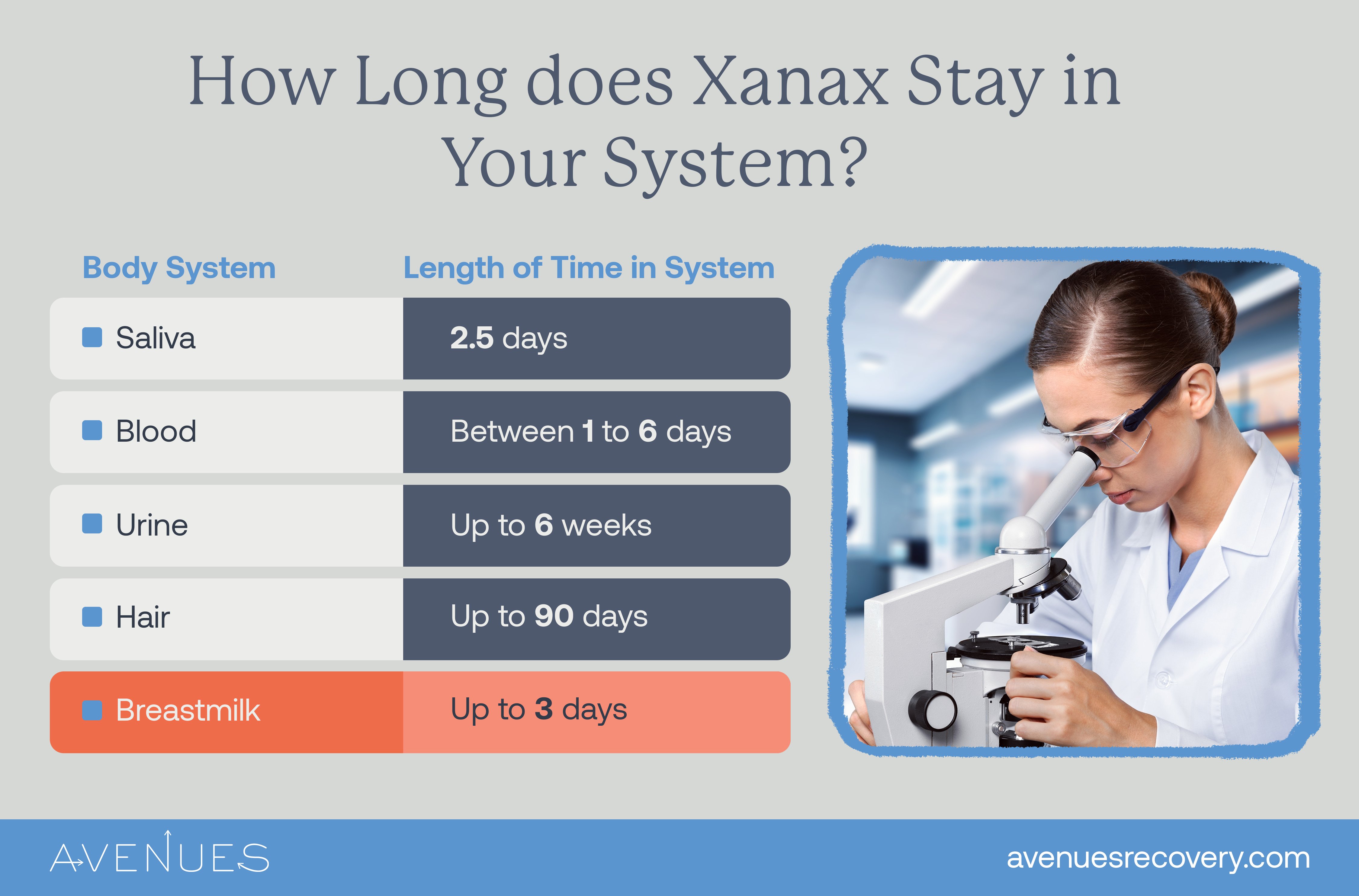Part of the complete guide to understanding addiction
Xanax takes, on average, 1-2 days to leave your system. The exact amount of time Xanax takes to leave your system varies based on several factors, including dosage, metabolism, liver and kidney function, age, and overall health.
In this article, Avenues Recovery, leading experts in the addiction recovery industry, explores Xanax's half-life, factors that affect how long Xanax remains in your system, and how long Xanax is detectable in your urine, hair, blood, saliva, and breastmilk.
What Is Xanax?
Xanax is the brand name of the drug Alprazolam, a sedative used to treat anxiety and panic disorders as well as muscle spasms, seizures, and sleep disorders. Alprazolam belongs to a wider family of drugs known as benzodiazepines, which act by increasing the effects of GABA (or gamma-aminobutyric acid), a natural chemical found in the brain. Once ingested, Xanax stays in your system for varying amounts of time depending on the dosage.
Xanax is classified as a Schedule IV controlled substance, which means that it has a low risk of abuse or dependence. This classification is somewhat incorrect however, since Xanax has been proven to possess a high potential for abuse and addiction, and suddenly stopping to use the drug can result in severe and even life-threatening withdrawal symptoms. Abusing Xanax may result in overdose and even death. In fact, the state of Alabama has made moves to re-classify Xanax as a Schedule II Substance, together with opioids and other drugs that have a high dependence and abuse potential.
How Long Does Xanax Stay in Your System: Metabolism of Xanax
Xanax is rapidly absorbed into the bloodstream after ingestion, and it usually reaches peak plasma concentration within one to two hours after ingestion. After two hours, the body slowly begins to process and excrete the drug.
Once Xanax is absorbed by the body, it is metabolized (or processed) in the liver by the hepatic enzyme system [1] It is processed into 2 main metabolites: alpha-hydroxyalprazolam and 4- hydroxyalprazolam. These metabolites are excreted primarily through urine.
Half-Life of Xanax
People using Xanax may be wondering how long Xanax remains in the system. To understand how long Xanax remains in the system, it’s important to look at the Xanax half-life.
“Half-life” means the amount of time it takes for half of a given amount of drug to leave your body. Knowing the half-life of a drug is important since it is an accurate way of estimating how long it will take to be flushed from your system. It usually takes a few half-life cycles until a drug is eliminated entirely.
The average half-life of Xanax is 11.2 hours in healthy adults. (However, it can range from anywhere between 6 and 27 hours based on individual factors – especially obesity.) This means that if someone took a 10 mg dose of Xanax, after 11 hours there will be 5 mg remaining in their system. After another 11 hours there will be 2.5 mg remaining, after yet another 11 hours there will be 1.25 mg remaining, and so forth. Altogether, it would take around 35 hours for a 10 mg dose of Xanax to be completely eliminated from the body and be undetectable in a Xanax drug test.
How Long Does Xanax Stay in Your System? Saliva, Blood, Urine, Hair and Breastmilk
Xanax can be detected in the body for up to 90 days after use. It’s important to note though, that this timeframe can be impacted by several factors, including age, gender, race, metabolism, dosage, and frequency of use.
How Long Does Xanax Stay In Your Saliva?
Xanax usually remains in saliva for up to 2.5 days after the last use.
How Long Does Xanax Stay In Your Blood?
How Long Does Xanax Last In Your Urine?
How Long Does Xanax Last In Hair?
How Long Does Xanax Stay In Breastmilk?

Xanax Half Life Chart
The Xanax half life chart below sums up these numbers:
| Body System | Length of Time in System |
| Saliva | 2.5 days |
| Blood | Between 1 to 6 days |
| Urine | Up to 6 weeks |
| Hair | Up to 90 days |
| Breastmilk | Up to 3 days |
Factors that Affect Xanax Elimination
There are a variety of factors that can affect the elimination time of Xanax and slow its release from the body. These factors include:
- Age
As one ages, metabolism and other bodily systems slow down. An older person will likely take longer to clear Xanax from their system through drug detox treatment. - Gender
Women often possess a weaker gastrointestinal system than men [2], resulting in a longer half-life and slower processing and removal of Xanax. - Body fat
Like all benzodiazepines, Xanax is a lipophilic (fat-loving) drug, so those with a higher concentration of body fat will take longer to clear the drug from their system. - Speed of metabolism
Those lucky people who have been gifted with a strong metabolism will process Xanax more quickly than others. - Liver and kidney health
If one’s liver and kidneys are in poor health, or failing entirely, they will likely be unable to digest Xanax properly, and it will remain in their body for an extended period of time. - Dosage and Frequency
Higher dosages of Xanax will take longer to eliminate from the body. Likewise, those who take the drug regularly may have traces of Xanax lingering in their system for longer periods of time. - History of use
Prolonged use of Xanax can lead to drug accumulation in the body, causing it to take more time to clear the system. - Use of Other Substances
Certain medications, illicit substances, and alcohol may interfere with the metabolism of Xanax, prolonging its elimination time.
Responsible Xanax Use
It’s crucial to understand how long Xanax stays in your system for various reasons – including safety during drug use, employment screenings, and to avoid any potentially adverse effects. While the half-life of Xanax is relatively short, depending on individual factors, its complete elimination may take days to weeks. To ensure safe usage and reduce the risks of dependence or withdrawal, patients should always follow their doctor’s instructions regarding dosage and use. One who is on Xanax and is considering Xanax withdrawal should make sure to consult with their provider to develop a safe tapering plan.
No Matter How Long Xanax Stays in Your System, There is Treatment Available
If you or a loved one is struggling with Xanax or any other substance abuse, know that there is hope, and help is always available. Reach out to Avenues Recovery today to speak with a skilled admissions representative who can walk you through your treatment options, and answer any questions you may have. We’ve helped thousands of people rehabilitate from drug abuse and we can help you too.
Begin your journey home today!
Sources



